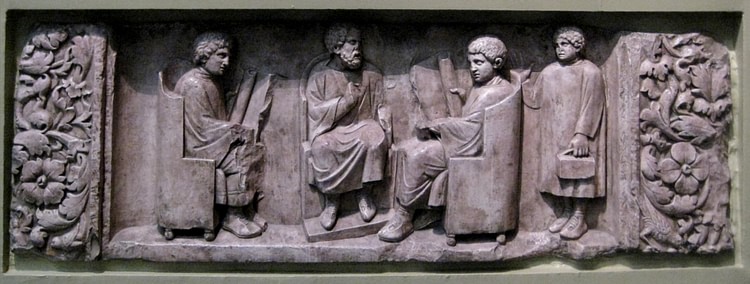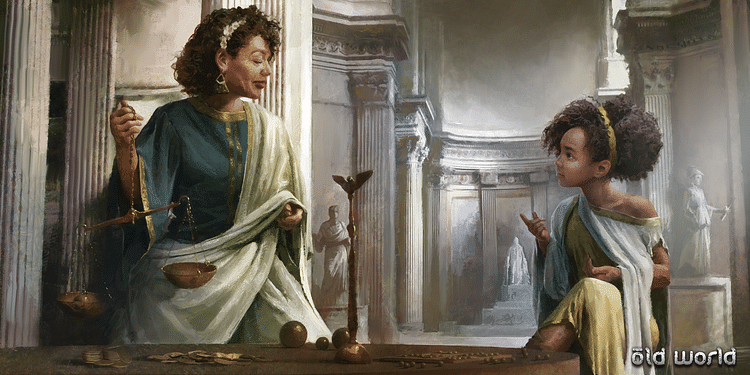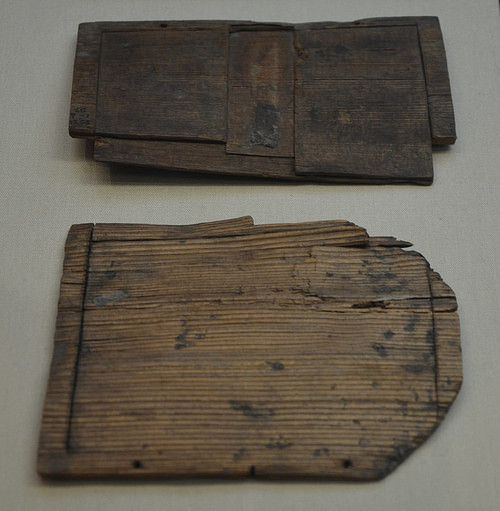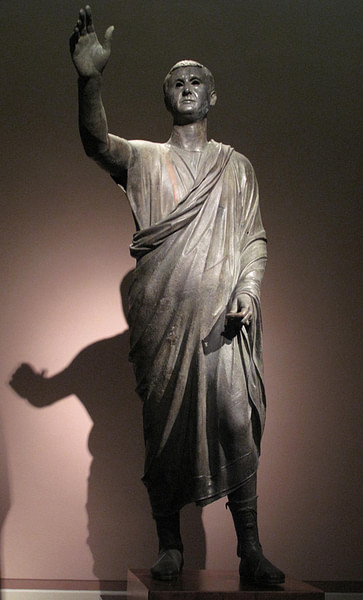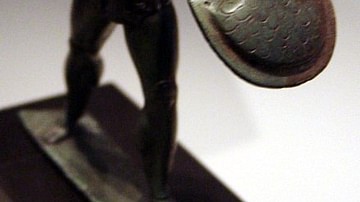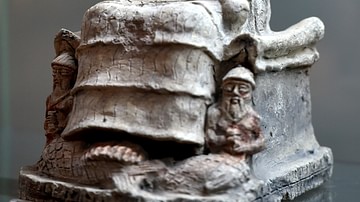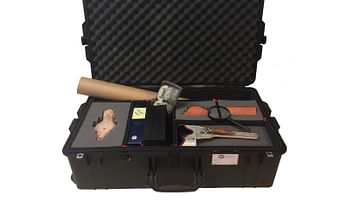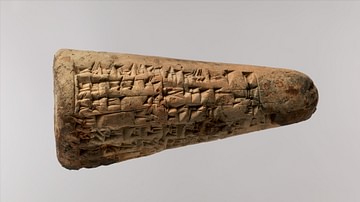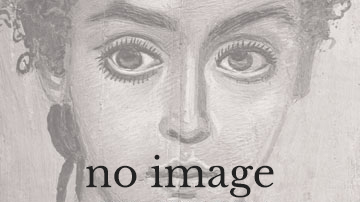Roman education had its first 'primary schools' in the 3rd century BCE, but they were not compulsory and depended entirely on tuition fees. There were no official schools in Rome, nor were there buildings used specifically for the purpose. Wealthy families employed private tutors to teach their children at home, while less well-off children were taught in groups.
Schools
Teaching conditions for teachers could differ greatly. A tutor who taught in a wealthy family did so in comfort and with facilities; some of these tutors could have been brought to Rome as slaves having been captured during war times, and they may have been highly educated. Other teachers, employed by the less well-off rented a room to hold classes or set up a school in the extended area of a shop, which the Roman historian, Suetonius (69 to c. 130/140 CE) refers to as a pergula (Gram.18.1). It was not uncommon for poorer teachers to hold classes for their students in outdoor public places – the trivium – the corner of the street, or in the piazzas. Classes began at dawn and continued until noon. The Roman poet, Martial (38/41-103 CE), complained about being woken at dawn by the booming voice of a teacher and his outdoor class: "Before the crested rooster has crowed you shatter the silence with your harsh words..." (Ep. 9.68).
Schools were privately operated by teachers and therefore dependent on tuition fees. Teachers were of relatively low status, and throughout antiquity, the profession was seen as a humble one. Schoolteaching was seen as a trade, in the servile commercial sense, and it paid poorly.
Parents paid the school fees in instalments at the end of each term, however, this was not a certainty; they did not always pay due to not having the money to do so, or because they were unhappy with the progress of their child, and as a result, teachers often found themselves in difficult financial positions. In the education hierarchy, the litterator (primary teacher), who required no special qualifications, was on the lowest level of income. In 301 CE, the salary for a primary teacher was 50 denarii a month per pupil; a bushel (c. 35 l) of wheat was 30 denarii. The grammaticus, a more prestigious position as an advanced educator is recorded in 301 CE as receiving a salary of 200 denarii per pupil per month. The rhetor, the teacher of rhetoric, required greater skills and expertise, and as a result, there were opportunities for achieving a good salary.
Students
The educator and orator, Quintilian (35-96 CE) believed that school was preferable to home education as the child benefited from the social community of the school. Education for children began proper at seven years of age. Most pupils were boys, but girls did attend, especially at primary level; girls rarely advanced beyond the first level as they tended to be married in their early teens.
The size of a school appears to have varied greatly. Martial in his Epigrams writes of Munna getting a third student (14. 223), however, Quintilian refers to a crowd (Quint. Inst. II. 32-4) in the grammar and rhetoric schools. The teacher sat in a large chair with his students sitting in a semicircle around him, or in rows before him. The usual seating for students in the classroom space was backless stools. School desks did not exist, and the student placed his tablet on his knees to work. A class may contain students of different ages and abilities, and they tended to work independently. The teacher did not teach his class as a whole; each student would come individually to him to receive instructions and to read out his completed lessons. Teachers had access to limited teaching materials, books were rare, and writing materials were expensive. They recited passages, which the students memorised for study purposes. Children learned to recite from memory poetry, grammatical treatises, and obscure words and their meanings.
Equipment
Students brought with them to their place of learning, waxed tablets and equipment which included a sponge for erasing, a knife for sharpening reed, and a ruler; these items were carried in a small case known as a theca. Those children who came from wealthier households may have had a slave accompany them to class. Papyrus was rarely used as it was expensive; where it was used it would have been in single sheets or broadsheets sewn together to make exercise books. More commonly, exercises were written on ostraca – broken pieces of pottery. Teachers also used large ostraca for writing out long passages or collections of moral maxims. Wooden tablets were also used, and some would come in notebook form. Tablets could have a surface coated in wax on which a sharp stylus made of metal, wood, or bone was used for writing, or the surface could be unwaxed on which pen and ink were used.
Curriculum
There were three levels of education: the basic Three Rs was the first stage. The litterator was responsible for teaching the younger children. Lessons included teaching the child to form and write letters; the teacher carving the alphabet into a wooden board and then having the child trace the letters. The tablets used by children were usually small enough to fit in one hand, and as a consequence would not hold a lot of text. Students were able to write quite small letters, about one centimetre (0.39 inch) in height, and with practice this size reduced to 0.5 cm (0.19 inch). They learned the shapes and names of the letters, then the syllables, and finally the construction of words and sentences. Children also copied out sentences, which should not be useless but, according to Quintilian in his textbook Institutio Oratoria, should carry some moral lesson for the child so that "the impression made upon his unformed mind will contribute to the formation of his character" (1.1 31-34).
The skill of reading was somewhat harder to acquire than today. Ancient books were more difficult to read as most texts had no spaces between the words, no distinction between capital and lower-case letters, no paragraphs, and no punctuation. Arithmetic for the students began with counting on their fingers and with pebbles (calculi), and then they moved on to using an abacus. They also learned their addition and multiplication by chanting. Many children did not advance any further than this stage.
The second stage for students aged ten to eleven was study with the grammaticus; children moving onto this level would usually have come from the more affluent classes. Many of these children may have learned to read and write at home and then went directly to the grammaticus, who would develop and refine their writing and speaking and teach them Greek. Suetonius writes of a time when the grammaticus engaged in certain kinds of exercises suited to the training of orators, such as problems, addresses, paraphrases, and character sketches, so that they would not be handing their students to the rhetoricians wholly ignorant or unprepared. These students also learned music, philosophy, astronomy and natural science.
When they were given the toga of manhood, students who were sometimes as young as 15 years, could move onto the third stage, which would require a teacher of rhetoric. A rhetor trained students in public speaking, Roman law and politics, astronomy, geography, literature, philosophy, music, and mythology. Students would study with their rhetor until the age of 20 or even later. The rhetor was tasked with educating them to become skilful orators; they were given exercises to develop their skills, which included declamations, a rhetorical piece on an invented theme for political and forensic oratory. The declamation exercises tackled scenarios of familial or social disorder by reasserting the commonly held views of the Roman elite in the still impressionable minds of the young.
Suetonius recalls his own school days when his rhetor would declaim and engage in discussion every alternative day, sometimes giving instruction in the morning and in the afternoon declaim. Students were given topics and asked to compose speeches. two categories of speech are referred to by Seneca the Elder (55 BCE to 39 CE) in his collection of declamations:
- suasoria – a fictitious speech in which the speaker gives advice to a historical or semi-historical character regarding the character's future conduct, intended to persuade someone to adopt a certain course of action.
- controversia – a fictitious speech in which one argued for one side of a point of law.
Quintilian's commentary paints us a picture of these young boys standing to give their speeches and being generously applauded and loudly praised by their fellow classmates without any regard for the quality of their fellow student's speech.
Discipline
As in any school environment, there were those times of distraction; Lucian recalls that he made little oxen and horse figures from the wax of his writing tablets (Dream 2). There were arguments amongst the children, and of course, the age-old tactics employed to avoid work; Persius describes how to blur his vision he "... would smear ointment on my eyes when I did not want to work on a speech" (Sat. 3. 44-47).
Although physical punishment was used by many teachers as a way of disciplining, some teachers employed different methods as incentives to stave off boredom and distraction; Suetonius writes of one teacher's method:
For to stimulate the efforts of his pupils, he used to pit those of the same advancement against one another, not only setting the subject on which they were to write, but also offering a prize for the victor to carry off. (Gram. 17.1)
These competitions, Suetonius notes, rewarded the successful student with the prize of an old book, valuable for its beauty and rareness.
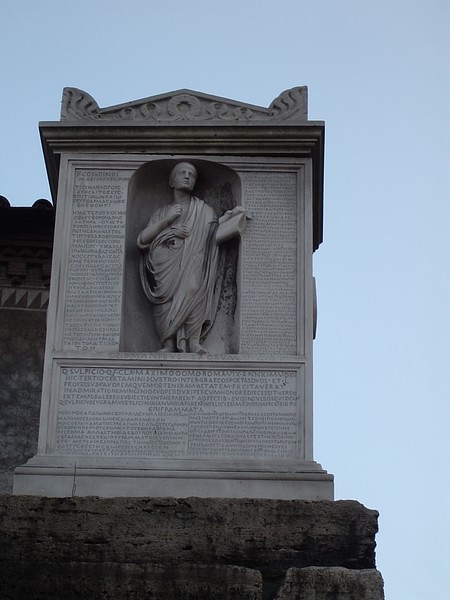
The importance of education was highlighted by educators like Quintilian, who wrote of the child being nourished, educated, and his inborn intellect being sharpened. Education was not made compulsory. Many would have remained illiterate. Those boys of the poorer classes, whose parents could afford to send them to school, did not go any further than primary education, having learned the practical skills that they required to be able to find employment. Girls, too, having had a basic education, could begin work at this early age. The child from the wealthier classes was afforded the luxury of a full education which prepared them for positions in upper-class society. It was not uncommon for some young men to continue their studies abroad in places like Athens, with Greek masters.
